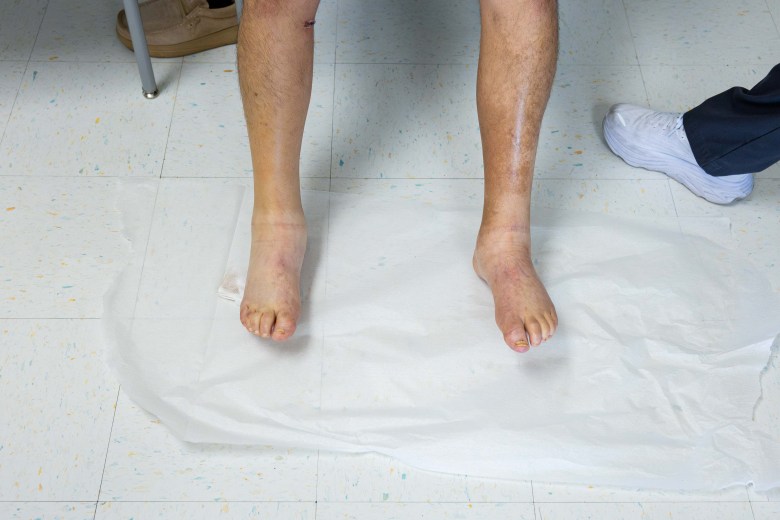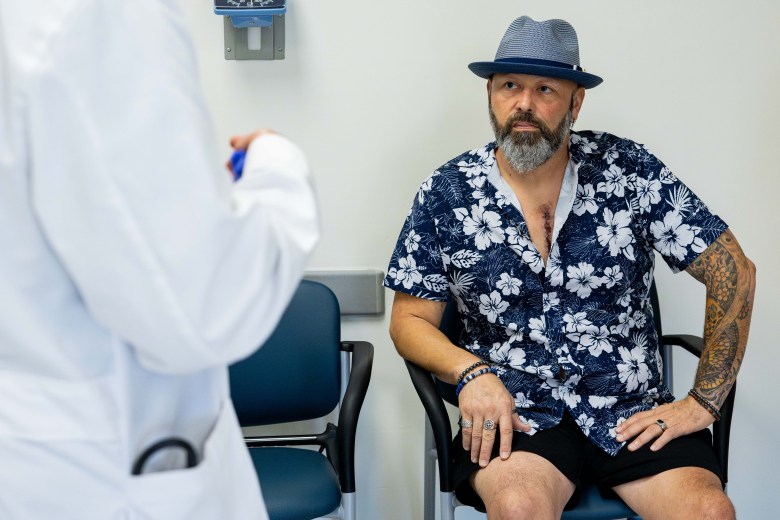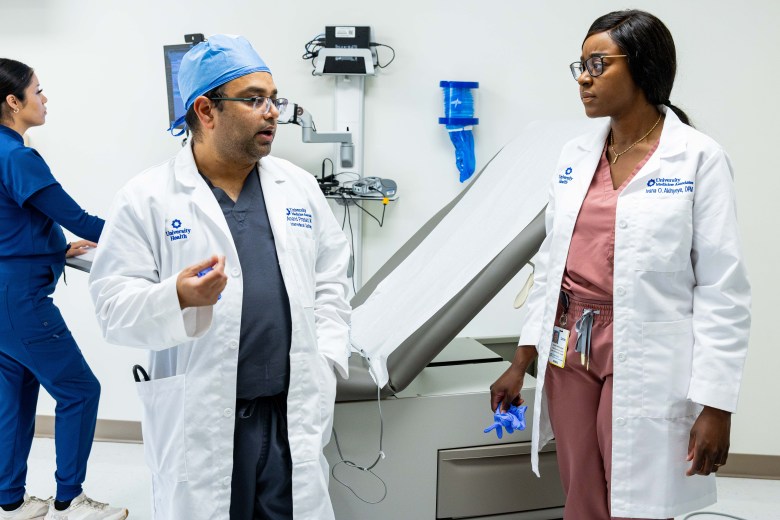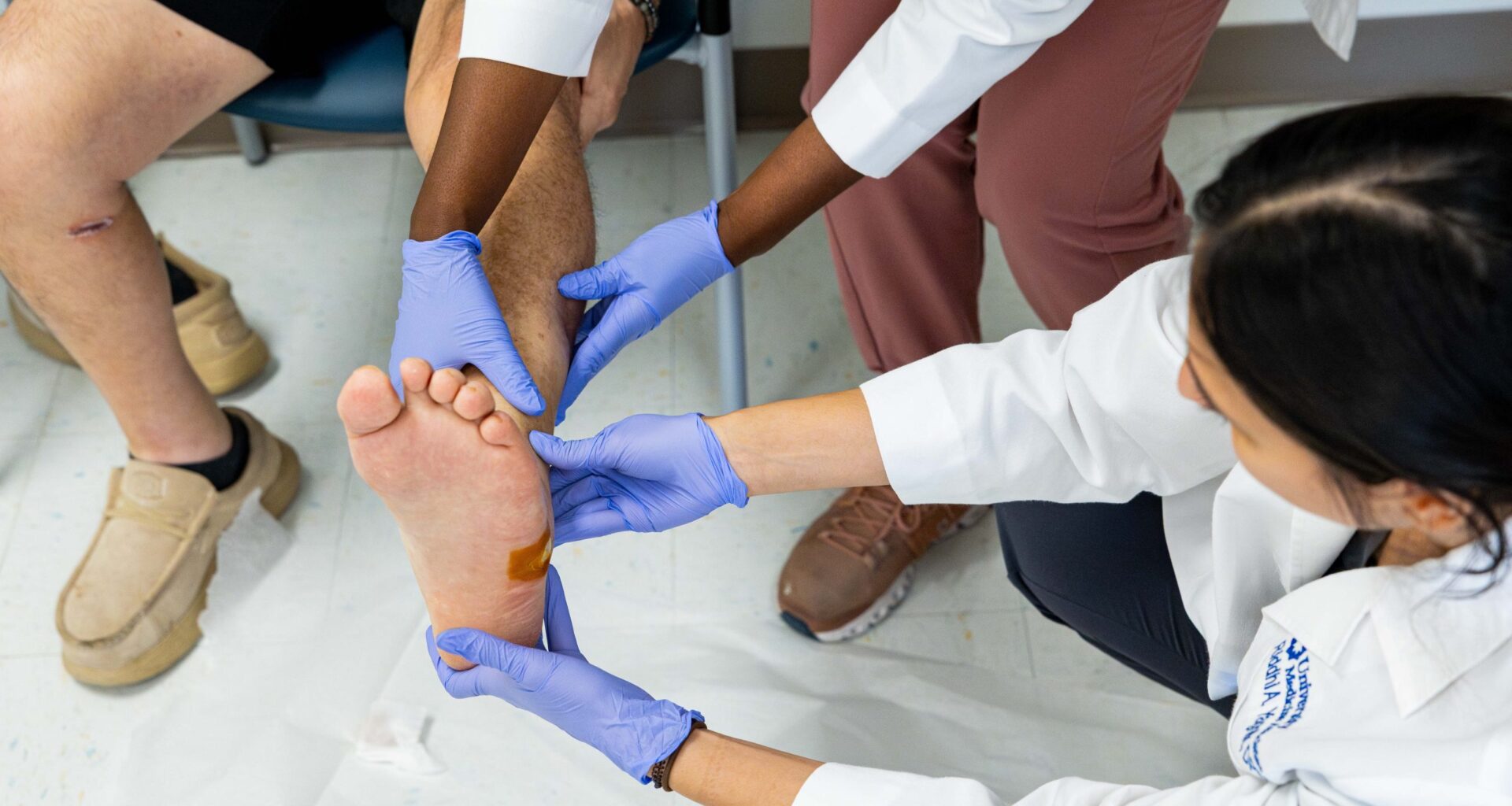In a University Health exam room, doctors are unwrapping bandages from the swollen feet of 50-year-old Charlie Treviño.
“I got a couple of tree trunks,” Treviño jokes about his legs and feet.
A stitched wound running down the center of Treviño’s chest peeks out just above his shirt, revealing where surgeons entered to perform a triple heart bypass surgery last week.
Treviño, who also has diabetes, is the first patient to be seen at the county-owned hospital system’s new Limb Salvage Clinic, a part of the Texas Diabetes Institute.
Though Treviño’s heart surgery is done, blood flow to his legs and feet is still limited. Treviño, who worked in construction, noticed his first foot ulcer, a small red sore, while on the job in June. As a result, he had to step away from work to focus on his health.
These sorts of foot wounds are somewhat common for people who suffer from diabetes and vascular disease. If they aren’t treated properly, what starts out as a small sore can become infected, potentially requiring amputation and leading to lifelong disability.
 Texas Diabetes Institute patient Charlie Trevino said there is history of heart disease in his family and diabetes is present in both his mother and father’s sides of the family tree. Credit: Amber Esparza / San Antonio Report
Texas Diabetes Institute patient Charlie Trevino said there is history of heart disease in his family and diabetes is present in both his mother and father’s sides of the family tree. Credit: Amber Esparza / San Antonio Report
“These are things that can turn within two days,” University Health podiatrist and clinic director Dr. Anand Prasad tells Treviño. “You can go from this and then you have a secondary infection.”
The clinic was opened in part because of the prevalence of diabetes in San Antonio, which Dr. Michael Sobolevsky, also a podiatrist and director of the clinic, described as the “diabetic foot capital of the world.” Housed in the Texas Diabetes Institute on South Zarzamora Street, the clinic will bring podiatrists, cardiologists and other physicians under one roof serve patients with cardiovascular disease and diabetes.
University Health is in the midst of expanding their cardiology and podiatric teams, according to their public relations manager Shelley Kofler. Their goal is to see at least 20 patients a week at the clinic. But based on the current volume of patients, they could reach that goal earlier, Kofler said.
In Bexar County, roughly 15% of the population — as many as 239,000 people — have been diagnosed with diabetes, above both the state average of 14% and the national average of 11%, according to 2022 data from University Health.
Some San Antonio zip codes have rates above 20%. And in the nearby Rio Grande Valley, rates reach 30%. The rates tend to be higher in Black and Hispanic populations, and in disadvantaged communities.
“We are behind the times in cardiovascular care here,” Prasad said. “We’re playing catch-up to some of the bigger cities. We’re growing faster. Our disease is growing, and the medical community is falling behind. We’re actually underserved, if you can believe it, in cardiologists in San Antonio.”
 Charlie Trevino listens to Dr. Anand Prasad after University Health podiatrists examined his legs and feet on Wednesday. Prasad tells Trevino they will continue the planned surgery for his foot ulcer after he has had more time to heal from his triple bypass heart operation just last week. Credit: Amber Esparza / San Antonio Report
Charlie Trevino listens to Dr. Anand Prasad after University Health podiatrists examined his legs and feet on Wednesday. Prasad tells Trevino they will continue the planned surgery for his foot ulcer after he has had more time to heal from his triple bypass heart operation just last week. Credit: Amber Esparza / San Antonio Report
Somewhere between one-third and one-quarter of people with diabetes will get a foot ulcer in their lifetime, Prasad said. These occur — and are slow to heal — because of reduced blood flow, nerve damage and foot deformities that can occur in diabetic patients. Peripheral artery disease and other vascular diseases, which often go along with diabetes, can also lead to these wounds and amputations.
About 34 million Americans suffer from diabetes, and more than 100,000 of them will have limbs amputated each year as a result.
The new clinic will focus on minimally invasive procedures to increase blood flow in the extremities and wound care to prevent amputations. For Treviño, he’ll need a balloon angioplasty — a tiny medical balloon that pushes through plaque buildups in his arteries — and dissolvable stints to open up blood flow to his legs.
The biggest benefit of the clinic will be that podiatrists will work closely with cardiologists to care for patients, both in addressing wounds when they happen and working to prevent them by managing the patients’ diabetes and vascular disease.
“It’s difficult for patients to make multiple appointments,” Dr. Ivana Akinyeye, a podiatrist, said. “So it’s nice to have different specialties in one clinic where the patients can be taken care of quickly. Because with the diabetic ulcers, time is of the essence.”
 Interventional Cardiologist Dr. Anand Prasad, left, and Podiatrist Dr. Ivana Akinyeye discuss treatment during a University Health Limb Salvage Clinic patient appointment on Wednesday. Credit: Amber Esparza / San Antonio Report
Interventional Cardiologist Dr. Anand Prasad, left, and Podiatrist Dr. Ivana Akinyeye discuss treatment during a University Health Limb Salvage Clinic patient appointment on Wednesday. Credit: Amber Esparza / San Antonio Report
“We’re going to build this in a very multidisciplinary way,” Prasad added. “We’re already talking to some vascular surgery colleagues. We have our podiatry team. We’re also really supported by a hospital system that’s going to make this a priority.”

